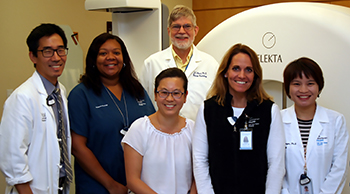
Gamma Knife care team members include (l-r): James Yu, MD, radiation oncologist; Violet Ratchford, radiation therapist; Veronica Chiang, MD, director, Gamma Knife Center; James E. Bond, PhD, medical physicist; Marnie Dickens, RN; and Ngoc Nguyen, PhD, medical physicist.
YNHH’s “Knife” that’s not a knife has helped changed many a life
The technology isn’t new, but for many patients with tumors, blood vessel abnormalities and nerve problems in or near the brain, Gamma Knife treatment can be revolutionary.
Gamma Knife isn’t actually a knife. It’s a form of stereotactic radiosurgery in which gamma radiation from 192 sources is precisely focused onto tumors or other targets in the brain. At the target, where the beams intersect, the radiation dose is very high, which makes it effective. However, since each individual radiation beam is low-intensity, the brain surrounding the target is virtually unaffected. Patients are usually treated in one day, on an outpatient basis and without general anesthesia.
“We can treat even difficult-to-reach areas of the brain with surgical precision, without making an incision or opening the skull,” said Veronica Chiang, MD, director, Gamma Knife Center. “Patients experience minimal complications, and Gamma Knife has a very high success rate.”
Gamma Knife has been in use worldwide for more than six decades. Twenty years ago, Yale New Haven Hospital became the first – and remains the only – Connecticut hospital to use it. The Gamma Knife team recently treated the program’s 5,000th patient.
Most patients are treated for cancer that has spread to the brain from the skin, breast, lung, colon, kidney or almost any other part of the body, said Kathleen Scott, regional manager, Smilow Radiation Oncology. Gamma Knife is also used to treat blood vessel abnormalities such as arteriovenous malformations and benign brain tumors such as meningiomas, acoustic neuromas, pituitary adenomas and craniopharyngiomas.
Typically, patients have a frame attached to their heads to ensure they don’t move during treatments. This makes Gamma Knife the only radiosurgery device that can guarantee accurate radiation targeting with the least amount of normal brain tissue exposure, Dr. Chiang said. Last year, Smilow began using Gamma Knife Icon, which uses advanced imaging and motion-management technology so certain patients can be treated with no head frame, without compromising targeting precision.
The Gamma Knife services team includes radiation oncologists, neurosurgeons, radiation therapists, nurses and radiation physicists.
“Because we have a clinical team dedicated to the program, we can often treat patients the day after they’re referred for Gamma Knife treatment,” Scott said. “The diagnosis of a brain tumor is, understandably, frightening for patients,” said James B. Yu, MD, radiation oncologist. “Knowing that we can provide a non-invasive treatment that has a long history of success helps reduce their anxiety.”